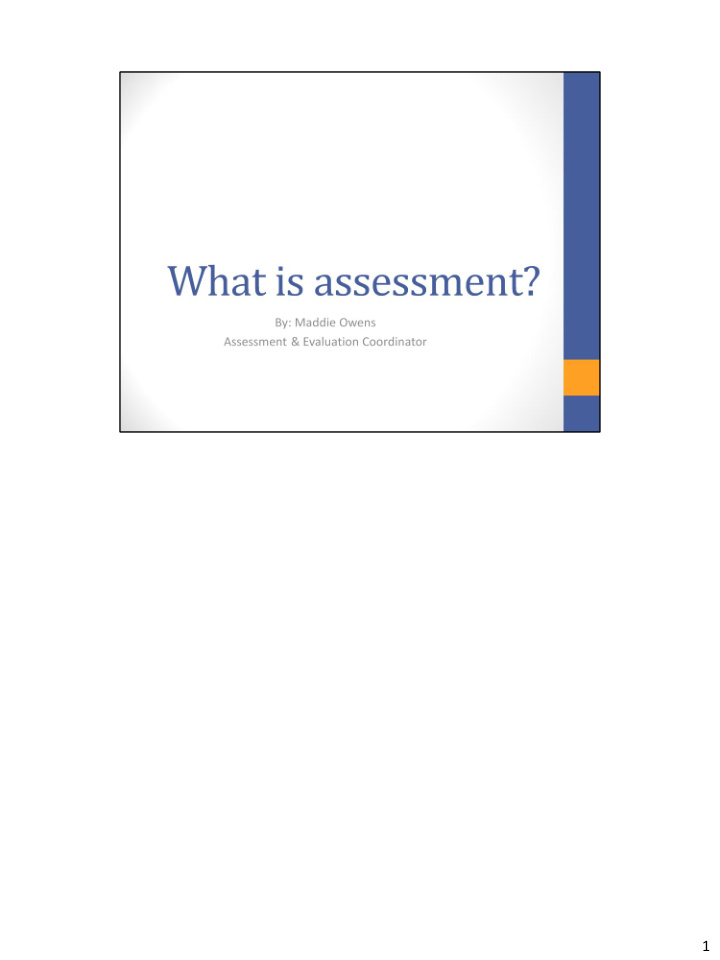



1
2
3
4
5
What does Eastern want their students to get out of the EIU experience… then where do EIU students learn? It’s important then, to make sure that the programs we put on for students are effective *use assessment* 6
7
Used: planned with a purpose, focused on goals, and the results are used by multiple individuals cost-effective: Realistic, given the financial technological, and human resources that need to be involved Results: Developed thoughtfully with a clear goal and purpose Valued: results inform important decisions and are part of an institutional culture that values asking questions and using information to make decisions Why do … ? – Once you know this, you’ll know what to assess, as this is the impact you hope to make 8
Tracking usage: track participation in programs or services Needs Assessment: Gathering information about student needs related to a particular program, office, or population Program Effectiveness: level of satisfaction, involvement, effectiveness, helpfulness, etc. Environmental Assessment: Used to assess the behaviors/attitudes on campus Learning: Used to determine how a participant will think, feel, or act differently as a result of your program/course/service Benchmarking: Comparing a program/service against a comparison group or standard Cost-effectiveness: how does a program or service offered compare with the cost? Program review: A comprehensive review of a department that typically involves the writing of an in-depth self-study and an external review process. 9
Learning – describes how students will think, know, do, or feel differently because of a learning experience. Operational/program – describes how a program/services/system/office will change as a result of a planned course of action 10
11
Existing Data: Any data that has already been collected, usually from previous assessments, student information systems, office systems, card swiping or other tracking systems. Survey : A set of open and closed-ended questions in a questionnaire type format, a survey is a self-report of anything, including opinion actions and observation Rubric: A scorecard used to rate student learning either through observation or artifacts. Includes a scale, key dimensions, and descriptions of each dimension on the scale Focus Groups or Interviews: The process of asking face-to-face open-ended questions in a group or one-on-one setting. Questions are meant to be a discussion Portfolio: A collection of artifacts or work that provide evidence of student learning or program improvement Observation: A systematic method of collecting data through unobtrusive visual means, (e.g., watching people or places) in order to collect information Document Analysis: A form of qualitative research, sometimes referre4d to as content analysis, in which documents are used to give voice, interpretation and meaning. Any document can be used, common documents may be: application materials, duty logs, reflection papers, student newspapers, or publications, marketing materials, meeting minutes, strategic planning documents, etc. Classroom Assessment Techniques: A form of short formative evaluations used by facilitators to monitor student learning before, during, and between workshops, learning experiences, exams or assignments and to then adapt instructional strategies to better meet student needs. Visual Methods : Captures images as a main form of data collection, usually also includes captions or a journal to accompany images. Most often used for photo journals, video projects, and visual art projects. Case study: A form of qualitative descriptive research, the case study looks intensely at an individual, culture, organization, or event/incident. 12
13
14
15
16
17
Coding is a good tool to use if you’re unsure of what you’ll find, or don’t have a specific framework already in place Raw data should only be used when the people you are presenting the data to are close to the project, and there is a very small amount of data collected. Narrative: narratives tell stories, narratives present each theme or code in paragraph form, usually with some explanation or interpretation by the author. Number: Counts, scales on rubrics. Use caution when presenting coded qualitative data in number format, you should still look for a way to present the voice of the respondents. 18
Bad response – doesn’t meet national average of 20% (as of 2013), doesn't fall within the 95% confidence and 0- 6% error levels, demographics don’t line up --- need to note that the results don’t represent the ideas of everyone. “responses indicate” instead of “students at EIU think..” also include demographic information in the response 19
20
Clarify – Common definition, include in job postings the position includes assessment Collaboration – don’t do it in a vacuum, work with other departments! 21
22
Recommend
More recommend